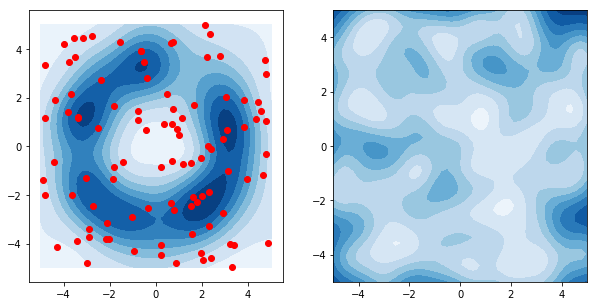Bayesian Quadrature
Bayesian quadrature (BQ) is a numerical integration method that works best on low-dimensional and expensive integration tasks. BQ can use active learning to query the integrand at locations that give the most information about the integrand and is thus quite sample efficient.
Bayesian quadrature returns not only an estimator but a full posterior distribution on the integral value which can be used in downstream decision-making and uncertainty analysis [1, 2].
Bayesian quadrature is especially useful when integrand evaluations are expensive and sampling schemes prohibitive, for example when evaluating the integrand involves running a complex computer simulation, a real-world experiment, or a lab. But even when evaluation cost is manageable, the sheer amount of queries that might be required by classical algorithms is usually incentive enough to favor a smarter and less wasteful approach.
Instead, Bayesian quadrature draws information from the structure of the integrand such as regularity or smoothness, and is thus able to learn faster from fewer integrand evaluations. Such structure is encoded as prior in the BQ model. In Emukit, the surrogate model for the integrand would be the emulator and the integrand itself that can be queried, would be the simulator, e.g., a real system or complex computer simulation.
Bayesian Quadrature in the Loop
Like other sequential learning schemes, Bayesian quadrature iteratively selects points where the integrand will be queried next such that an acquisition function is maximized. The acquisition function is specific to the integration task and encodes, for example, how much a potential integrand evaluation will inform the unknown integral value. In turn, the probabilistic model—usually a Gaussian process—is updated with the newly collected evaluation and refined at each step by optimizing its hyperparameters. The actual integration that yields the distribution over the integral value is then performed by integrating the emulator or an approximation thereof. Usually this surrogate integral is analytic and requires little computation in comparison to queries of the integrand.
Thus, Bayesian quadrature is based on three things: i) replacing an intractable integral with a regression problem on the integrand function ii) replacing the actual integration with an easier, analytic integration of the emulator on the integrand function, and iii) actively choosing locations for integrand evaluations such that the budget is optimally used in the sense encoded by the acquisition scheme.
Bayesian Quadrature in Emukit
Emukit, among others, provides functionality for vanilla Bayesian quadrature where a Gaussian process surrogate model is placed upon the integrand which is then integrated directly. This is how it is done:
First we define the function that we want to integrate. It is called user_function in the code block below. Here we choose the 1-dimensional Hennig1D function which is already implemented in Emukit (see here for a visualization). We also choose the integration bounds: A lower bound and an upper bound.
from emukit.test_functions.quadrature import hennig1D
user_function = hennig1D()[0]
lb = -3. # lower integral bound
ub = 3. # upper integral bound
Next we choose three locations for some initial evaluations to get an initial model of the integrand, also called the initial design. Here we use the GP regression model of GPy since a wrapper already exists in Emukit. Note that in BQ we are usually restricted in the choice of the kernel function. Emukit supports a couple of different kernels such as the RBF kernel used here.
import numpy as np
import GPy
X = np.array([[-2.],[-0.5], [-0.1]])
Y = user_function.f(X) # inital integrand evaluations at locations X
gpy_model = GPy.models.GPRegression(X=X, Y=Y,
kernel=GPy.kern.RBF(input_dim=X.shape[1],
lengthscale=0.5,
variance=1.0))
Now we convert the GPy GP model into an Emukit quadrature GP. Note that we also need to wrap the RBF kernel of the GPy model since Bayesian quadrature essentially integrates the kernel function. We integrate with respect to the Lebesgue measure whose domain is defined by the integral bounds.
from emukit.model_wrappers.gpy_quadrature_wrappers import \
BaseGaussianProcessGPy, RBFGPy
from emukit.quadrature.kernels import QuadratureRBFLebesgueMeasure
from emukit.quadrature.measures import LebesgueMeasure
emukit_rbf = RBFGPy(gpy_model.kern)
emukit_measure = LebesgueMeasure.from_bounds(bounds=[(lb, ub)])
emukit_qrbf = QuadratureRBFLebesgueMeasure(emukit_rbf, emukit_measure)
emukit_model = BaseGaussianProcessGPy(kern=emukit_qrbf, gpy_model=gpy_model)
Among others, Emukit supports vanilla Bayesian quadrature where the GP model directly emulates the integrand function. Other approaches may emulate a transformation the of the integrand (see e.g., [3]).
from emukit.quadrature.methods import VanillaBayesianQuadrature
emukit_method = VanillaBayesianQuadrature(base_gp=emukit_model, X=X, Y=Y)
Now we define the active learning loop. The essential piece in the loop is the acquisition function. The vanilla BQ loop by default uses the integral-variance-reduction acquisition (IVR) which measure how much the uncertainty about the integral value will shrink were we to evaluate the integrand at a certain location. The next evaluation of the integrand will be chosen such that the IVR is maximized. IVR is a global quantity of the space meaning that it takes into account what we learn about other locations in space if we evaluate at a local point.
from emukit.quadrature.loop import VanillaBayesianQuadratureLoop
emukit_loop = VanillaBayesianQuadratureLoop(model=emukit_method)
Finally, we run the loop for num_iter = 20 iterations. This will collect 20 additional integrand evaluations, chosen by optimizing the acqusition function at every step. After each newly collected evaluation, the vanilla BQ model is updated and fitted to the new dataset.
num_iter = 20
emukit_loop.run_loop(user_function, stopping_condition=num_iter)
And that’s it! You can retrieve the integral and variance estimator by running
integral_mean, integral_variance = emukit_loop.model.integrate()
Check our list of notebooks and examples if you want to learn more about how to do Bayesian quadrature and other methods with Emukit. You can also check the Emukit documentation.
We’re always open to contributions! Please read our contribution guidelines for more information. We are particularly interested in contributions regarding examples and tutorials.
Refereces on Quadrature
- [1] O’Hagan (1991) Bayes-Hermite Quadrature, Journal of Statistical Planning and Inference 29, pp. 245–260.
- [2] Diaconis (1988) Bayesian numerical analysis, Statistical decision theory and related topics V, pp. 163–175.
- [3] Gunter et al. (2014) Sampling for Inference in Probabilistic Models with Fast Bayesian Quadrature, Advances in Neural Information Processing Systems, 27, pp. 2789–2797.
